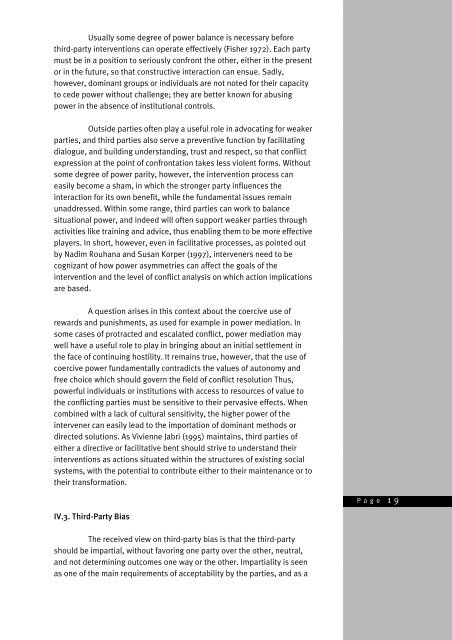Methods of Third-Party Intervention - Berghof Handbook for Conflict ...
Methods of Third-Party Intervention - Berghof Handbook for Conflict ...
Methods of Third-Party Intervention - Berghof Handbook for Conflict ...
Create successful ePaper yourself
Turn your PDF publications into a flip-book with our unique Google optimized e-Paper software.
Usually some degree <strong>of</strong> power balance is necessary be<strong>for</strong>e<br />
third-party interventions can operate effectively (Fisher 1972). Each party<br />
must be in a position to seriously confront the other, either in the present<br />
or in the future, so that constructive interaction can ensue. Sadly,<br />
however, dominant groups or individuals are not noted <strong>for</strong> their capacity<br />
to cede power without challenge; they are better known <strong>for</strong> abusing<br />
power in the absence <strong>of</strong> institutional controls.<br />
Outside parties <strong>of</strong>ten play a useful role in advocating <strong>for</strong> weaker<br />
parties, and third parties also serve a preventive function by facilitating<br />
dialogue, and building understanding, trust and respect, so that conflict<br />
expression at the point <strong>of</strong> confrontation takes less violent <strong>for</strong>ms. Without<br />
some degree <strong>of</strong> power parity, however, the intervention process can<br />
easily become a sham, in which the stronger party influences the<br />
interaction <strong>for</strong> its own benefit, while the fundamental issues remain<br />
unaddressed. Within some range, third parties can work to balance<br />
situational power, and indeed will <strong>of</strong>ten support weaker parties through<br />
activities like training and advice, thus enabling them to be more effective<br />
players. In short, however, even in facilitative processes, as pointed out<br />
by Nadim Rouhana and Susan Korper (1997), interveners need to be<br />
cognizant <strong>of</strong> how power asymmetries can affect the goals <strong>of</strong> the<br />
intervention and the level <strong>of</strong> conflict analysis on which action implications<br />
are based.<br />
A question arises in this context about the coercive use <strong>of</strong><br />
rewards and punishments, as used <strong>for</strong> example in power mediation. In<br />
some cases <strong>of</strong> protracted and escalated conflict, power mediation may<br />
well have a useful role to play in bringing about an initial settlement in<br />
the face <strong>of</strong> continuing hostility. It remains true, however, that the use <strong>of</strong><br />
coercive power fundamentally contradicts the values <strong>of</strong> autonomy and<br />
free choice which should govern the field <strong>of</strong> conflict resolution Thus,<br />
powerful individuals or institutions with access to resources <strong>of</strong> value to<br />
the conflicting parties must be sensitive to their pervasive effects. When<br />
combined with a lack <strong>of</strong> cultural sensitivity, the higher power <strong>of</strong> the<br />
intervener can easily lead to the importation <strong>of</strong> dominant methods or<br />
directed solutions. As Vivienne Jabri (1995) maintains, third parties <strong>of</strong><br />
either a directive or facilitative bent should strive to understand their<br />
interventions as actions situated within the structures <strong>of</strong> existing social<br />
systems, with the potential to contribute either to their maintenance or to<br />
their trans<strong>for</strong>mation.<br />
IV.3. <strong>Third</strong>-<strong>Party</strong> Bias<br />
The received view on third-party bias is that the third-party<br />
should be impartial, without favoring one party over the other, neutral,<br />
and not determining outcomes one way or the other. Impartiality is seen<br />
as one <strong>of</strong> the main requirements <strong>of</strong> acceptability by the parties, and as a<br />
Page 19

















